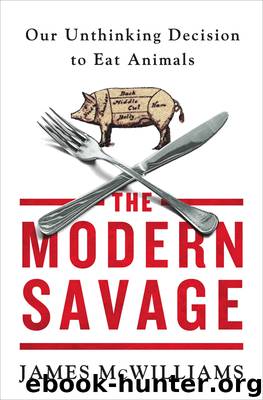The Modern Savage by James McWilliams

Author:James McWilliams
Language: eng
Format: epub
ISBN: 9781250031204
Publisher: St. Martin's Press
“DO NOT TEASE THE MICROBES”
Because easy answers to chicken health problems remain elusive, many small-scale chicken owners resort to an arsenal of medications and chemicals to keep their birds healthy. We tend to associate the systematic application of vaccines and antibiotics to farm animals with factory farming, not alternative farms, where conditions are perceived to be “natural.” But nonindustrial operations, even some organic ones, frequently rely on vaccines, antibiotics, fungicides, and pesticides as a cost of doing business. Consider the account of one chicken keeper whose flock came down with a variety of conditions: “I haven’t lost any. Been treating [the mysterious disease] really well, but, I am out of Gallimycin [antibiotic that fights respiratory disease], till my order comes in! I am giving the 4 really bad ones LA-200 [another antibiotic] injections, and injections to the other sick pen. I have Terramycin [yet another antibiotic] in the water now, as well as Probios. I am also terrymincining [sic] everyone else as a precaution. All are getting VetRx [compound that treats worms and colds] at the moment too.”48 Through the use of medicated feed, vaccinations, antibiotic-laced water, potent pesticides, and a host of other drugs, small-scale egg farms routinely employ the same techniques used by industrial producers to prevent and cure bird disease. That they do so on a smaller scale is falsely reassuring.
The most common vaccine that hatcheries administer to chickens is the vaccine for Marek’s disease. This drug contains strains of chicken and turkey herpesvirus, penicillin, and a fungiastic agent called Fungizone. The vaccine is given either embryonically or, more commonly, under the skin behind the necks of one-day-old chicks. The USDA forbids a vaccinated chicken to be slaughtered for consumption within twenty-six days of receiving the drug.49 While some backyard chicken owners refuse to vaccinate their flocks under any circumstances, this is the exception that proves the rule. The consensus on every established backyard chicken forum—and certainly within the veterinary community—is to vaccinate for Marek’s. When a woman asked a backyard chicken forum if she should purchase chickens that have been vaccinated for Marek’s, the collective answer was unequivocal: “After what I’ve been through, I would vaccinate everyone”; “It’s cheap, it saves lives, and there’s really no risk”; “It is a TERRIBLE disease, and i would think anyone stupid for not vaccinating against it!”; “It’s a horrible disease and I only wish I had vaccinated. I would have saved lives and saved myself alot [sic] of crying.”50 In a word: yes, vaccinate.
Vaccination might seem to be an innocuous measure for a small farmer to take. Nonindustrial reliance on vaccination, however, implicates small-scale animal farming alongside factory farms in the insidious cycle of viral resistance that routinely makes the news as an endemic agricultural problem. It fuels the pharmaceutical arms race we are so quick to condemn as specific to industrial agriculture. A 2005 article published in Expert Review of Vaccines explored this issue in some depth. It wondered if the use of Marek’s vaccines “could be driving the virus to greater virulence.
Download
This site does not store any files on its server. We only index and link to content provided by other sites. Please contact the content providers to delete copyright contents if any and email us, we'll remove relevant links or contents immediately.
Craft Beer for the Homebrewer by Michael Agnew(18140)
Marijuana Grower's Handbook by Ed Rosenthal(3619)
Barkskins by Annie Proulx(3297)
Project Animal Farm: An Accidental Journey into the Secret World of Farming and the Truth About Our Food by Sonia Faruqi(3174)
The Plant Messiah by Carlos Magdalena(2881)
Red Famine: Stalin's War on Ukraine by Anne Applebaum(2872)
0041152001443424520 .pdf by Unknown(2783)
Organic Mushroom Farming and Mycoremediation by Tradd Cotter(2626)
In the Woods by Tana French(2529)
Beer is proof God loves us by Charles W. Bamforth(2369)
7-14 Days by Noah Waters(2359)
Reservoir 13 by Jon McGregor(2239)
Borders by unknow(2226)
Meathooked by Marta Zaraska(2220)
The Art of Making Gelato by Morgan Morano(2215)
Birds, Beasts and Relatives by Gerald Durrell(2175)
Between Two Fires by Christopher Buehlman(2163)
The 7 Habits of Highly Effective People: Powerful Lessons in Personal Change (25th Anniversary Edition) by Covey Stephen R(2135)
The Lean Farm Guide to Growing Vegetables: More In-Depth Lean Techniques for Efficient Organic Production by Ben Hartman(2096)
